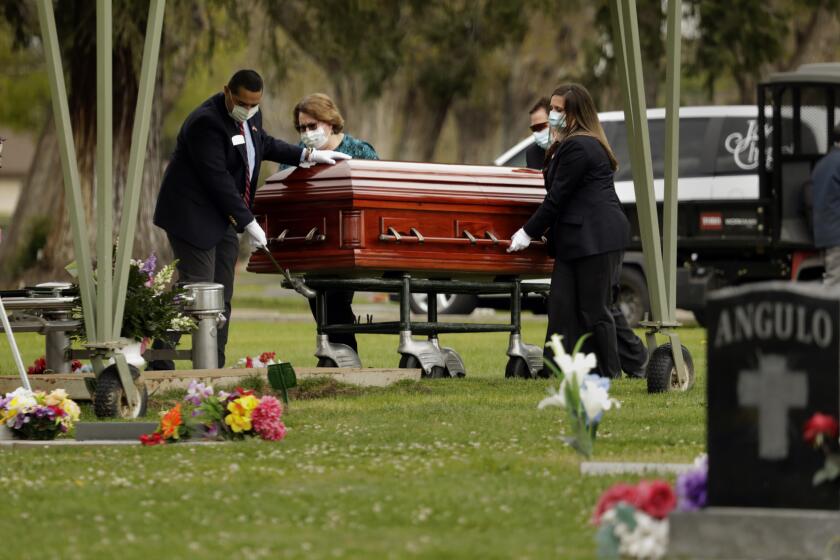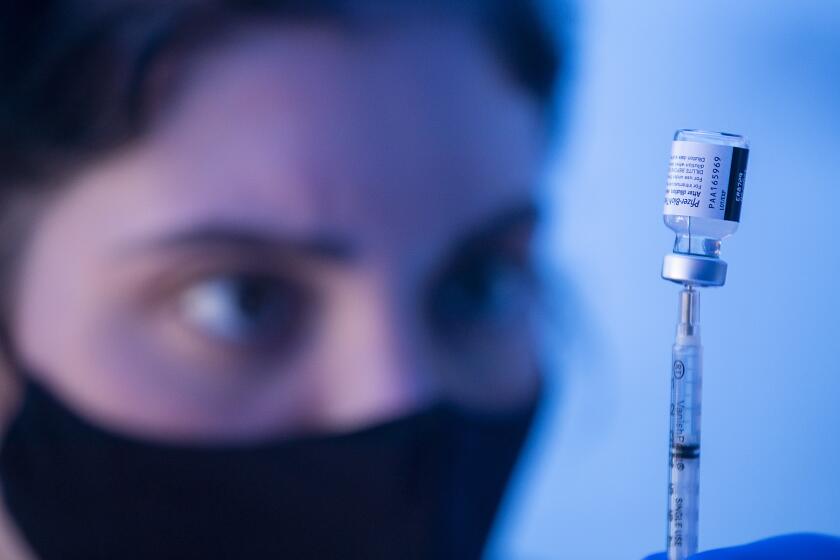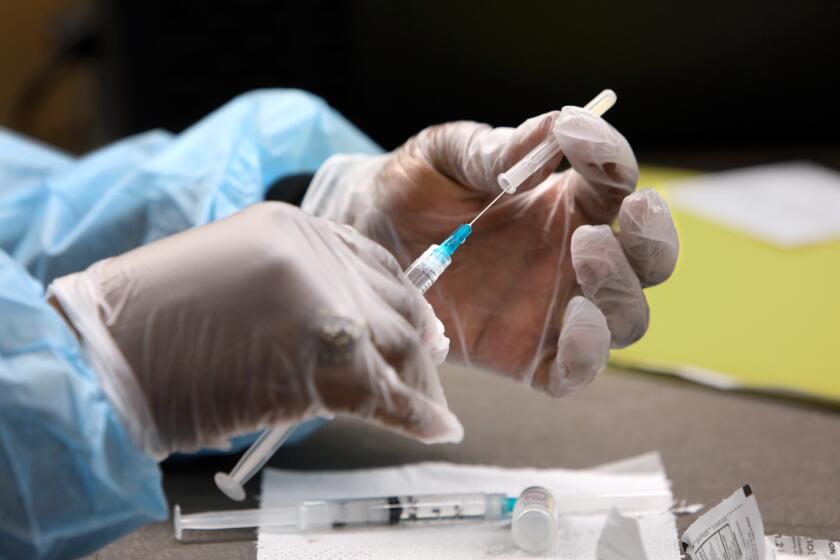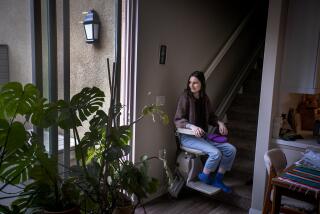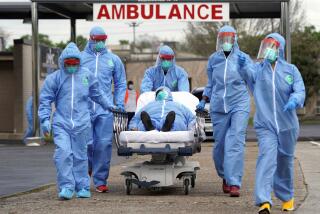Nearly 5 out of 6 coronavirus cases were undetected in pandemic’s early months
- Share via
Scientists at the National Institutes of Health who studied blood samples from across the United States have discovered that for every coronavirus infection recorded during the spring and summer of 2020, nearly five more went undetected — amounting to nearly 17 million additional cases by July 2020.
The discovery, published this week in the journal Science Translational Medicine, reveals that the coronavirus was far more widespread in the early months of the COVID-19 pandemic than previously thought, and could help scientists and health officials better respond to future outbreaks.
At the beginning of the pandemic, experts realized many infections were slipping under the radar. But without the means to implement a comprehensive testing program, the extent of the undercount was unknown, said Dr. Ellen Foxman, an immunologist at Yale University.
“That was the big question: For each infection that we actually do diagnose, how many are we not diagnosing?” said Foxman, who was not involved in the new research.
Many studies attempted to tackle this question in various ways. “But the problem is a lot of them had a very specific, small population that was being looked at,” she said — a cruise ship, say, or a shelter.
A team of immunologists, engineers, clinicians and statisticians across the NIH worked together to try and get a better handle on the number of undiagnosed coronavirus infections by looking for antibodies in blood samples. If antibodies to SARS-CoV-2 were present, it would be an irrefutable sign that the person’s immune system had encountered the virus.
Some of the researchers fine-tuned a mail-in test kit system that allowed participants to collect their own blood at home instead of having to visit a clinic for a blood draw. Volunteers used a lancet to prick their fingertip and squeeze out droplets of blood that they deposited into sampling devices. The dried blood spots could then be mailed to the NIH, where the samples were screened for antibodies.
Scientists are skeptical of the Institute for Health Metrics and Evaluation’s new way of counting COVID-19 cases and their claim that the pandemic’s toll is twice as bad as we thought.
This user-friendly mail-in format meant the scientists could gather samples from far and wide, said Kaitlyn Sadtler, an immunologist and bioengineer at the NIH’s National Institute of Biomedical Imaging and Bioengineering and one of the paper’s senior authors.
“We had samples from Alaska, we had samples from Hawaii,” Sadtler said. Basically, “if a delivery truck can make it to your house, we could get a sample from you.”
The scientists had planned to recruit about 10,000 participants. Thanks to publicity about the work, they ended up with more than 240,000 volunteers — far more than they could feasibly study. So they used the demographic and geographic information the volunteers provided to select a group that was representative of the county’s population based on the U.S. census.
The scientists sent out about 11,000 kits over late spring and summer and received just over 9,000 back, most of them between May 10 and July 31. About 1,000 had incomplete information, but the rest could be analyzed.
The results: By last summer, after the first wave of the pandemic, there were roughly 16.8 million undiagnosed coronavirus infections in addition to the roughly 3 million that were confirmed. The researchers calculated that for every infection that had been officially tallied, about 4.8 others were uncounted.
With a more complete picture of coronavirus infections, the research team reported that:
- Antibody presence was far higher in women (5.5%) than in men (3.5%).
- Black Americans had the highest rate of past infection (14.2%), followed by Native American/Alaska Native (6.8%), Latino (6.1%), white (2.5%) and Asian (2%) volunteers.
- The youngest of the adult participants — those between age 18 and 44 — had the highest antibody prevalence (5.9%).
- People living in urban areas were far more likely to have antibodies (5.3%) compared with those from rural areas (1.1%).
- People in the mid-Atlantic and Northeast regions had the highest antibody prevalence (8.6% and 7.5%, respectively), while the lowest rate was in the Midwest (1.6%).
The study shows that these differences exist, not why they emerge. But experts are weighing possible explanations for at least a few of these trends — some biological, some behavioral and some systemic.
Two studies of hospital workers bolster the case that COVID-19 vaccines really do reduce the risk of a coronavirus infection.
For example, it’s possible that many younger people who were infected didn’t realize it because, unlike with older adults, they didn’t get especially sick. It’s also possible that younger people were more likely to be out in public and interacting with others, giving them more opportunity to encounter the virus.
The higher antibody rate in densely populated urban areas came as little surprise. The higher prevalence in the mid-Atlantic and Northeast regions also tracks, since they were the first areas to experience serious outbreaks.
As for the higher antibody prevalence among Black Americans and other people of color: This probably reflects long-standing healthcare disparities that the pandemic made even more apparent.
“We see this pattern also in diagnosed cases and deaths, and it is a reflection of inequities that prevent equal access to diagnostics, care, and treatment,” Sadtler said.
If scientists discover that immunity to the coronavirus starts to wane months or years after vaccination, a booster shot could be deployed.
Does the recognition of all these previously overlooked cases mean the country is closer to reaching herd immunity than previously thought?
Not necessarily, Sadtler said. It’s unknown how long the immunity gained from a coronavirus infection lasts, and whether this so-called natural immunity offers strong protection against an array of viral variants. (That’s a big concern now that the Delta variant, which may be twice as transmissible as the conventional strain, is spreading in the U.S.)
“Vaccines induce a very high level of antibodies — so, much stronger immunity than a previous infection,” she said. “We still need to make sure that everybody gets vaccinated, so everybody has strong and long-lasting immunity.”
Sadtler said the team is continuing to analyze follow-up samples sent in by the same group of participants, in the hopes of seeing whether any of them had a second coronavirus infection by January or February of this year.
